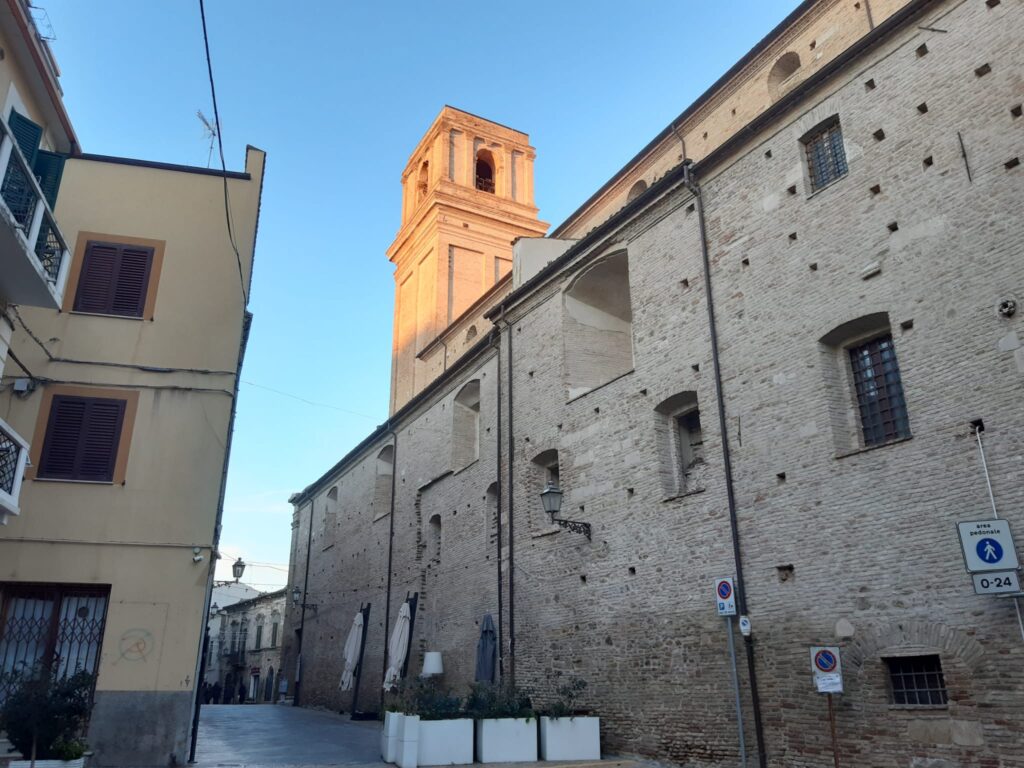In Santa Maria Maggiore, traces of the past dating back to the early centuries of Christianity are visible, representing the oldest core of the medieval city. This area was once part of the “castellum,” the nucleus of urban revival after the depopulation following the Gothic War in the sixth century.
By 427, a church dedicated to Saint Eleutherius was already documented here. There was also a Norman stronghold called “La Battaglia,” which was part of the first city walls. With the arrival of the Swabians, we have the first official record of the church’s existence when King Henry VI of Germany, in 1195, confirmed Santa Maria in Guasto Aimone as a church under the Benedictine order of the significant Monastery of San Giovanni in Venere.
As the city expanded under Frederick II and the city walls were extended, the church was enlarged. In 1234, a vestibule was added, with columns still visible today on the outer part of the right nave along what is now Via Santa Maria.
During the Angevin period, in 1331, the bell tower was built on the ruins of La Battaglia, featuring a tower with two pointed windows on each side. Some architectural details from this 14th-century structure remain on the exterior of the left nave, particularly a walled-up bifora visible from Via Tiziano, behind the bell tower.

The church was destroyed in 1566 during an Ottoman raid led by Pialì Pascià. After its reconstruction by the D’Avalos family, it received as a gift the relic of the Holy Thorn from Francesco Ferdinando D’Avalos, who had been presented the relic by King Philip II of Spain for his representation at the Council of Trent. Following another fire in 1645, the church was rebuilt again by the D’Avalos, who enriched it with additional relics and works of art.
Notably, Don Cesare Michelangelo D’Avalos, who had been baptized in this very church in 1667, donated the relics of Saint Cesarius to Santa Maria in 1695, which are now housed in the crypt bearing his name. By the time Don Cesare became Marquis of Vasto, he commissioned the construction of the grand bell chamber between 1715 and 1730, completing the bell tower of Santa Maria. Additionally, thanks to Don Cesare, the church was granted the title of “Insigne Collegiata” by the Pope in 1734, with associated financial benefits.
Further expanded in 1785, Santa Maria Maggiore lost its title in 1809 when Joseph Bonaparte, King of Naples, abolished the chapters of Santa Maria and San Pietro, elevating the church of Sant’Agostino (later renamed San Giuseppe) in their place.
Despite this demotion, the presence of two powerful confraternities, the “Gonfalone” and “Sacra Spina”, allowed the church to continue expanding and embellishing. In 1838, renowned architect Nicola Maria Pietrocola, a native of Vasto, designed the current neoclassical interior, raising the presbytery and creating the crypt beneath it. With the construction of lateral naves, the church lost its original Latin cross plan, as the transept arms were incorporated into the naves, as seen by observing the walls of the right nave from Via Santa Maria.
Further modifications by architects Silvestro and Roberto Benedetti led to the completion of the Sacred Heart and Sacred Thorn chapels, located respectively in the left nave and at the end of the right nave, resulting in the current configuration of this Marian temple, which more than any other, represents the devotion of the people of Vasto and the history of the city.

